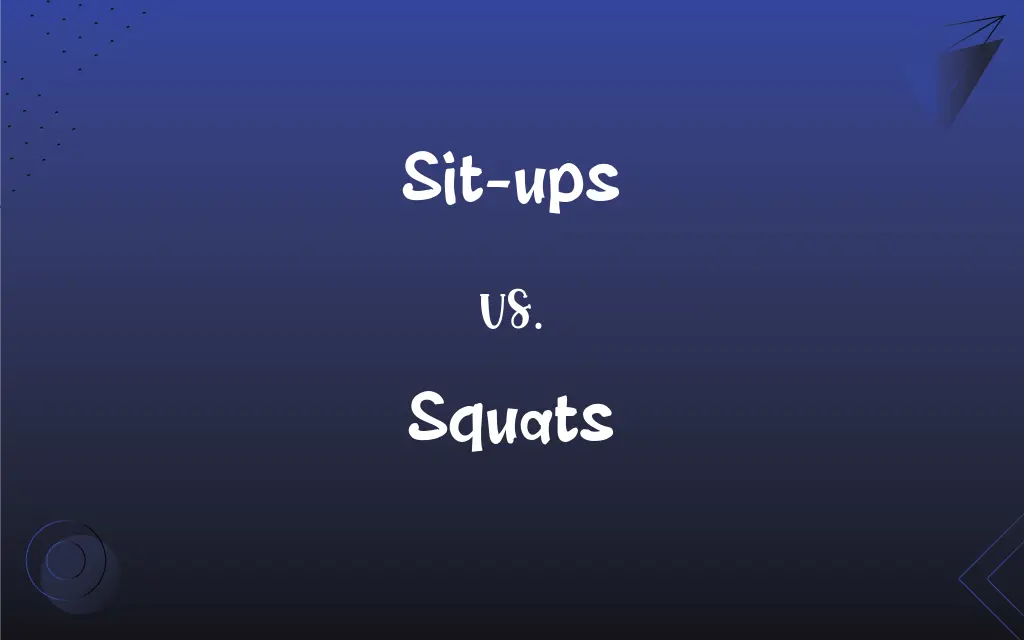Sit-ups vs. Squats: What's the Difference?
Edited by Aimie Carlson || By Janet White || Published on February 22, 2024
Sit-ups are a core-strengthening exercise focusing on the abdominal muscles, whereas squats are a lower-body workout targeting thighs, hips, and buttocks.

Key Differences
Sit-ups primarily work the abdominal muscles, aiding in core strengthening and stability. Squats focus on the lower body, targeting the quadriceps, hamstrings, glutes, and lower back muscles.
Sit-ups involve lying on your back and lifting your torso towards your knees. Squats require standing with feet shoulder-width apart and lowering the body by bending the knees, keeping the back straight.
Sit-ups aim to improve core strength, which is vital for balance and posture. Squats are effective for building lower body strength, improving flexibility, and supporting joint health.
Sit-ups can be modified for beginners by reducing the range of motion. Squats can be adjusted by altering depth, adding weights, or changing foot positioning for varied intensity.
Incorrect form in sit-ups can strain the neck and back. Squats, if performed improperly, can lead to knee and lower back injuries.
ADVERTISEMENT
Comparison Chart
Primary Muscle Group
Abdominal muscles
Quadriceps, hamstrings, glutes
Execution
Lying back, lifting torso
Standing, bending knees
Benefits
Core strength, posture improvement
Lower body strength, flexibility
Modifications
Reduced range of motion for beginners
Depth adjustment, added weights
Common Risks
Neck and back strain
Knee and lower back injuries
ADVERTISEMENT
Sit-ups and Squats Definitions
Sit-ups
An exercise focusing on abdominal muscles through torso movement.
He included sit-ups in his routine for a stronger core.
Squats
A strength training move involving bending of knees and hips.
He added squats to his routine to improve leg strength.
Sit-ups
A fitness activity to enhance abdominal endurance and stability.
Her trainer recommended sit-ups for better balance and posture.
Squats
An exercise that aids in enhancing lower body muscle and flexibility.
Regular squats have increased her lower body flexibility.
Sit-ups
A core exercise where one lifts their upper body from a lying position.
Daily sit-ups helped her improve her abdominal strength.
Squats
A fundamental exercise for overall leg and core strength.
Integrating squats into her routine improved her core and leg strength.
Sit-ups
A traditional workout for targeting the central abdominal area.
He performed sit-ups as part of his core strengthening regime.
Squats
A lower-body exercise focusing on thighs, hips, and buttocks.
Squats are essential for her leg day workouts.
Sit-ups
A physical exercise for toning and firming the belly region.
She found sit-ups effective for toning her midsection.
Squats
A workout targeting multiple muscle groups in the lower body.
Squats are known for effectively working out the entire lower body.
Sit-ups
A physical exercise in which one uses the abdominal muscles to raise the torso from a supine to a sitting position and then lies back down again without moving the legs.
Squats
To sit in a crouching position with knees bent and the buttocks on or near the heels.
Sit-ups
Plural of sit-up
Squats
To crouch down, as an animal does.
FAQs
What are squats?
Squats are a lower-body workout that involves bending the knees and hips.
What are sit-ups?
Sit-ups are an abdominal exercise where one lifts their torso from a lying position.
Are sit-ups good for core strength?
Yes, sit-ups are effective for building core strength.
Which muscles do squats work?
Squats target the quadriceps, hamstrings, glutes, and lower back.
Can squats help with leg strength?
Absolutely, squats are excellent for increasing leg strength.
Can sit-ups help lose belly fat?
While sit-ups strengthen muscles, fat loss requires a combination of exercise and diet.
Are squats effective for weight loss?
Squats can contribute to weight loss as part of a comprehensive fitness routine.
What are common squatting errors?
Common errors include improper knee alignment and not keeping the back straight.
Which muscles do sit-ups target?
Sit-ups primarily target the abdominal muscles.
What are some squat variations?
Variations include sumo squats, jump squats, and pistol squats.
What is the proper form for squats?
Keep your back straight, feet shoulder-width apart, and bend at the knees.
How often should I do squats?
Squats can be done 2-3 times a week as part of a balanced workout regime.
What are common mistakes in doing sit-ups?
Common mistakes include pulling the neck and not engaging the core.
Can sit-ups improve posture?
Yes, sit-ups can improve posture by strengthening core muscles.
Do squats help with balance?
Yes, squats can improve balance and coordination.
Are there different types of sit-ups?
Yes, there are variations like twisted sit-ups and leg-lift sit-ups.
Can sit-ups cause back pain?
Incorrect form in sit-ups can lead to back strain.
Are squats safe for my knees?
Squats are safe with proper form, but those with knee issues should consult a professional.
How many sit-ups should I do as a beginner?
Beginners should start with a small set, like 10-15 sit-ups.
Is it safe to do sit-ups every day?
Moderation is key; daily sit-ups are fine if not overdone and properly executed.
About Author
Written by
Janet WhiteJanet White has been an esteemed writer and blogger for Difference Wiki. Holding a Master's degree in Science and Medical Journalism from the prestigious Boston University, she has consistently demonstrated her expertise and passion for her field. When she's not immersed in her work, Janet relishes her time exercising, delving into a good book, and cherishing moments with friends and family.
Edited by
Aimie CarlsonAimie Carlson, holding a master's degree in English literature, is a fervent English language enthusiast. She lends her writing talents to Difference Wiki, a prominent website that specializes in comparisons, offering readers insightful analyses that both captivate and inform.







































































